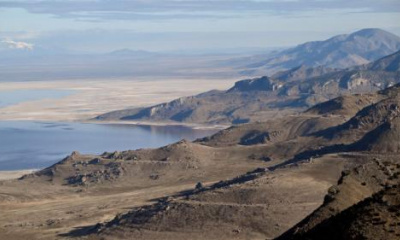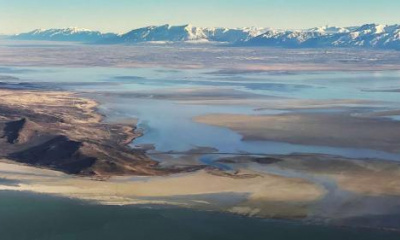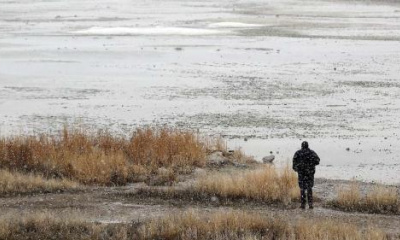The state engineer receives a deluge of applications for new diversions each year, but it appears many of them would be exempt from the pause.
Gov. Spencer Cox announced this month that all new water rights in the Great Salt Lake Basin are on pause, given the lake’s crisis situation.
The move sounds big, sweeping and dramatic — it applies to the lake’s main tributaries that drain nearly 10,000 square miles in Utah. Still, it’s hard to say how much of a difference it will make for the Great Salt Lake, which has continued to shrink after hitting another record low over the summer, almost entirely due to Utah’s water diversions.
The governor’s current suspension only applies to new water right applications and does not interfere with existing ones. New water rights would be the most junior with the lowest priority anyway. And in periods of drought, junior water right holders sometimes don’t get to divert any water at all.
Like many arid states in the West, much of Utah is over-appropriated, meaning more rights exist than actual water.
“This proclamation doesn’t have much impact because there’s so much paper water without wet water to service it,” said Zach Frankel, executive director of the Utah Rivers Council. “Cutting off new water appropriations for water that doesn’t really exist isn’t going to help the Great Salt Lake.”
State officials who manage the Great Salt Lake and its basin’s water, however, disagree.
“This is one of the most significant, single actions ever taken to save the Great Salt Lake,” said Joel Ferry, executive director of the Department of Natural Resources.
The lake would have double its volume and sit 11 feet higher if not for human water consumption, according to an evaluation by Utah State University and state agencies.
A spokesperson for Cox declined to answer a list of questions for this story, instead directing inquiries to representatives with DNR and the Division of Water Rights.
How much demand is there for new water rights in the Great Salt Lake basin?
Despite the limitations that come with super-junior water rights, the state engineer receives a deluge of new requests each year, according to data provided by the Division of Water Rights.
In the last five years, the division saw nearly 600 applications within the Great Salt Lake’s basin alone, looking to appropriate a whopping 517,818 acre-feet of additional water.
While the amount of water sought might seem astounding, a single application
A spokesperson for Cox declined to answer a list of questions for this story, instead directing inquiries to representatives with DNR and the Division of Water Rights.
How much demand is there for new water rights in the Great Salt Lake basin?
Despite the limitations that come with super-junior water rights, the state engineer receives a deluge of new requests each year, according to data provided by the Division of Water Rights.
In the last five years, the division saw nearly 600 applications within the Great Salt Lake’s basin alone, looking to appropriate a whopping 517,818 acre-feet of additional water.
While the amount of water sought might seem astounding, a single application significantly inflates it.
In 2018, the states of Utah and Idaho jointly filed for 400,000 acre-feet from the Bear River. The application is complicated and has nothing to do with the controversial Bear River development project. It mostly seeks to free up water stored in Bear Lake for flood control and instead release it at times that would be more beneficial to cities and farmers in both states. It also has not yet been approved by the state engineer.
The Central Utah and Jordan Valley water conservancy districts, along with Salt Lake City, have another pending joint application for 100,000 acre-feet, filed in 2021. It was a preemptive move after the apparently defunct Utah Lake Restoration Projectclaimed it would conserve a substantial amount of lake water through dredging and removal of invasive species. Water utilities wanted to ensure they had a right to those savings.
All said, the Division of Water Rights has only approved about 4,000 acre-feet of new diversions in the Great Salt Lake basin over the last five years, although it still represents hundreds of new water rights. It received 111 applications for 2022 alone.
The vast majority of those recently approved applicants plan to divert 2 acre-feet or less. And they are using the water mostly for domestic use, or some combination of domestic, irrigation and raising livestock.
“It’s more rural areas” seeking new water rights, said State Engineer Teresa Wilhelmsen. “... Box Elder County, Rich County, some in Wasatch and Summit, where there’s not a public [water] system but there’s private land.”
Under Cox’s proclamation, it seems many of those users would be exempt anyway — he makes exceptions for “small amounts,” defined in state code as the water needed for a single residence irrigating a quarter-acre and supporting 10 cows.
And most new water rights are not siphoning away the Great Salt Lake’s tributaries, like the Bear, Weber, Jordan and Provo rivers. They are drilling new wells. But signs are pointing to an overreliance on groundwater for domestic supplies, with communities across the Wasatch Back imposing building moratoriums due to shortages.
“There’s definitely a hydrological connection between groundwater and surface water,” Wilhelmsen said. “Part of this pause is to help us understand what that connection is.”
The suspension on new water rights lasts for a year. Wilhelmsen and her team will use that time to evaluate whether it is working and make recommendations to lawmakers about whether it should continue.








